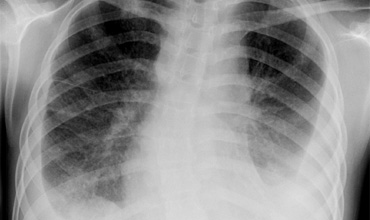Association of HIV to Pulmonary Tuberculosis in Chest Clinic of a General Hospital in Lagos, Nigeria

Abstract:
Objective:
To determine the prevalence rate of Human Immuno-deficiency Virus(HIV) among tuberculosis
(TB) patients in a general hospital in Lagos, Nigeria.
Methods: This is a cross-sectional
study. Demographic information was retrieved from the register of TB patients, HIV
testing was done through rapid testing and confirmation by the hospital laboratory.
Descriptive statistics was used to get the characteristics of the study participants.
Bivariate analysis was performed for estimation of odd ratio (OR) and 95% confidence
interval (CI). Chi square was utilized for the determination of the relationships
that exists between study variables. P-values <0.05 were considered significant.
Results:
All the 130 patients gave consent to be tested for HIV. Eighty-eight (88) of the
patients were male representing 67.7% of the patients and 85.4% of the patients
had sputum smear positive pulmonary tuberculosis (TB) while the rest were sputum
smear negative, 20 (15.4%) were HIV-positive. HIV prevalence among male patients
was 13.6% (p value=0.42), but 19.1% (p value=0.42)among female patients. Prevalence
of HIV among sputum smear positive pulmonary TB patients was 13.5% (p value=0.15)
and 26.3% (p value=0.15) among sputum smear negative patients.
Conclusions:
This study revealed that HIV prevalence is higher among
pulmonary TB patients than among the general population in Nigeria. It further lays
credence to the close link that exists between active TB and HIV/AIDS infection
in Nigeria, and the higher proportion of sputum smear negativity is found in HIV
positive patients. There is a need therefore for a program to address HIV/TB co-infection.
Keywords: Tuberculosis,
HIV, co-infection, Lagos, Nigeria.
References:
[1]. Akinleye, O.M.,
Alo, O.G., Salami, O.O., Alaka-Coker, A.A., Idris, M.G. and Onyeoghani, N. (2015).
Tuberculosis and HIV co-infection among patients attending directly observed treatment
short course (DOTS) in Lagos, Nigeria. Archives of Applied Science Research, 2015,
7 (7):69-74.
[2]. Barnes, P.F.,
Bloch, A.B., Davidson, P.T., Snider, D.E. (1991). Tuberculosis in patients with
human immunodeficiency virus infection. N. Engl. J. Med. 1991;324:1644-1650.
[3]. Daniel, O.J.,
O.T. Oladapo, A.A. Salako, C.A. Iyaniwura and F.A. Oluwole, 2005. Gender and TB/HIV co-infection: Presentation and treatment
outcome in Nigeria. Nig. Med. Practitioner, 47: 58-60.
[5]. Global HIV/AIDS
Initiative Nigeria (2010). GHAIN support to TB-HIV integration: End of project monograph.
Accessed on 28th August, 2015 at: http://www.fhi360.org/sites/default/files/media/documents/GHAIN%20support%20to%20TB-HIV%20integration.pdf
[6]. Hasnain, J.,
Memon, G.N., Memon, A., Channa, A.A., Creswell, J. and Shah, S.A. (2012). Screening
for HIV among tuberculosis patients: a cross-sectional study in Sindh, Pakistan.
BMJ Open 2012; 2:e001677. doi: 10.1136/bmjopen-2012-001677
[7]. Knox, G. and
R. Guglielmo, R. (2006). Global report on TB and HIV: New
analysis of TB/HIV epidemics in Bangladesh. Brazil, Nigeria, Tanzania and Thailand,
Press Release.
[8]. Onubogu, C.C.,
Kunle-Ope, C.N., Onyejepu, N., Nwokoye, N.N., Raheem, T.Y., Igbasi, U.T., Tochukwu,
N.E., Omoloye, R.M., Ejezie, C.O., Musa, A.Z., Odunukwe, N.N., Onwujekwe, D.I.,
and Idigbe, E.O. (2010). Prevalence of tuberculosis and human immunodeficiency virus
(TB/HIV) co-infections amongst patients with bronchopulmonary disorders in Lagos.
African Journal of Microbiology Research Vol. 4(18), pp. 1904-1908, 18 September,
2010 Accessed online on 27th August, 2015 at: http://www.academicjournals.org/ajmr
ISSN 1996-0808.
[9]. Nwachukwu, N.C.,
Orji, I.K., Okereke, H.C. (2009). Epidemiology of tuberculosis in some parts of
Abia State, Federal Republic of Nigeria. Asian J. Epidem., 2: 13-17.
[10]. Nwobu GO, Okodua
MA, Tatfeng YM. Comparative Study Of HIV Associated Pulmonary Tuberculosis In Chest
Clinics From Two Regions Of Edo State, NigeriaOnline J Health Allied Scs. 2004;3:4
[11]. Odaibo, G.N.,
Okonkwo, P., Lawal, O.M., and Olaleye, D.O. (2013). HIV infection among newly diagnosed
TB patients in southwestern Nigeria:A multi-DOTS centre study. World Journal of
AIDS (3):2, pp154-159. Accessed on 28th August at: (http://www.scirp.org/journal/wja)
[13]. Raizada N.,
Chauhan L.S., Khera A., Khera, A., Sokhey, J., Wares, D.F., Sahu, S.. Thakur, R.,
& Dewan, P.K. (2008). HIV seroprevalence among Tuberculosis patients in India,
2006–2007. PLoSOne 2008;3:e2970. doi:10.1371/journal.pone.0002970.
[14]. Tadese, S.,
and Tadese, T. (September, 2013). HIV co-infection among tuberculosis patients in
Dabat, northwest Ethiopia. Journal of Infectious Diseases and Immunity. Vol. 5(3),
pp 29-32. DOI 10.5897/JIDI2013.0117
[15]. Taura, W.D.,
Sale, I.T., and Mohammed, Y. (2008). The prevalence of tuberculosis in patients
attending the infectious diseases hospital Kano, Nigeria. Int. Jor. P. App. Sci.,
2: 63-69.
[16]. Umeh E.O.,
Ishaleku D., Hieukwumere, C.C. (2007). HIV/Tuberculosis coinfection among patients
attending clinic in Nasarawa State. J. Appl. Sci., 7: 933-935
[17]. UNAIDS (2015).
HIV and AIDS estimates 2014. Available at: http://www.unaids.org/en/regionscountries/countries/nigeria
[18]. UNAIDS. UNAIDS
World AIDS Day Report 2011. Geneva: UNAIDS, 2011. www.unaids.org/en/media/unaids/contentassets/documents/unaidspublication/2011/JC2216_WorldAIDSday_report_2011_en.pdf.
[19]. United Nations
Children's Fund (2013). Statistics at a glance: Nigeria. Last updated September
2013. Accessed on 28th August, 2015 at: http://www.unicef.org/infobycountry/nigeria_statistics.html
[20]. World Health
Organisation (2015). AIDS, TB and Malaria. WHO Regional Office for Africa, 2015.
http://www.afro.who.int/en/nigeria/country-programmes/aids-tb-and-malaria.html.
[21]. World Health
Organization (June 20th, 2004). Guidelines for HIV surveillance among
tuberculosis patients. 2nd edn. Geneva: WHO, 2004:11–3.

